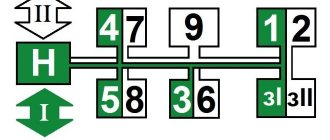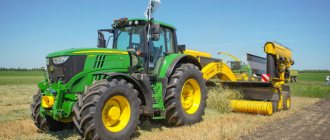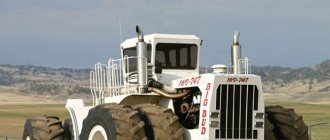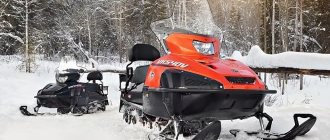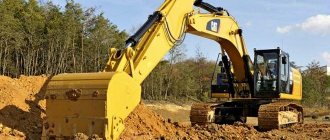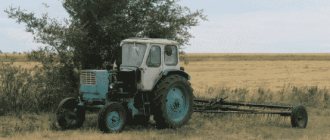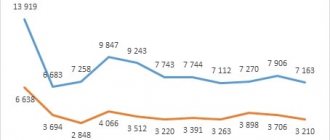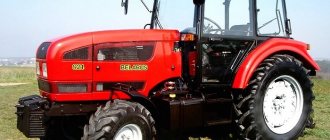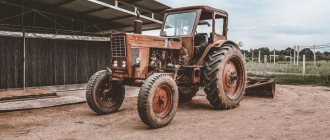You can start driving only after warming up the engine and checking its operation. Before driving, make sure there are no obstacles in front of the tractor and warn people standing nearby.
To get moving, perform the following operations:
- fully depress the clutch pedal
- smoothly engage the required gear
- Smoothly release the clutch pedal and start driving.
If the required gear does not engage the first time , move the gear shift lever to neutral , depress the clutch pedal a couple of times and engage the required gear.
When driving the tractor, release the clutch pedal smoothly.
Do not move jerkily , as this may lead to breakdown of the power transmission mechanism and premature wear of the clutch linings.
Operating a tractor requires utmost attention. While driving, you must monitor your surroundings and, if necessary, give warning signals.
How to drive a tractor?
Persons who have completed a training course in the direction “Fundamentals of control and traffic safety of tractors” are allowed to operate the tractor.
Before moving on to driving the tractor, a number of preparatory works are carried out:
- Check the serviceability of tractor components;
- Measure tire pressure;
- If there is attachments on the tractor, visually inspect the tow bracket;
- Remove the casing from the tractor power unit to ensure the proper condition of the battery, cooling system and radiator;
- Wear comfortable clothes and shoes, avoiding loose hair and jewelry;
- The driver's seat settings are adjusted to the height and weight of the operator. With your back resting on the seat, your hands should have free access to the tractor controls, and your feet should have free access to the pedals.
The tractor control process occurs as follows:
- They start the engine and begin to move away - the first attempt to move begins with a warm engine. To do this, reduce the fuel supply, turn off the clutch handle, select a working gear, increase fuel consumption and move the clutch pedal to the on mode;
- When the tractor has moved, they begin to accelerate it to the required speed - they reduce the fuel supply, disengage the clutch, set the desired mode on the gearbox, smoothly engaging the clutch;
- To make a turn at the end of acceleration and pull the plow out of the ground, the accelerator is set to minimum feed;
- Controlling the tractor during the first rut - laying the 1st furrow begins with setting a straight trajectory of movement. In flat areas, for this purpose, one pole and a sighting device are used, built into the tractor; for fields with complex geometry, several poles are required that delimit the entire field. On modern tractors, this control issue is solved faster - with the help of GIS technologies;
- When performing the main cycle of work, the tractor driver must constantly “maneuver” between gears – i.e. choose the optimal rhythm of work for a specific agrotechnical task and the characteristics of the cultivated area. So, to move up a slope and on clayey, loamy, gravelly and heavy chernozems, low gears are used, and in the opposite case, high gears;
- Turning and turning on the field is unacceptable with working adapters and at high speed. To turn the tractor on wheeled propellers, reduce the speed to 5 km/h and apply the brakes to the wheel that is in the center of the turning circle. Turning a caterpillar tractor is done only in extreme cases;
- Driving a tractor while going down a slope is an extremely dangerous maneuver, during which the load is shifted from the front wheels to the rear wheels. To perform it without the risk of an accident, reduce the diesel supply, select a low gear and periodically brake the engine;
- In order to drive a tractor with mounted adapters from the PTO without damage to the power plant and with safety for yourself, you must remember to turn off the power take-off when turning and switch them to transport mode - when going uphill. When moving between areas, it is advisable to disconnect the PTO shaft shank from the cardan drive.
These requirements apply to both factory models and homemade tractors from Niva or Oka.
Driving a tractor at night and during the day with poor visibility
When driving a tractor at night or during the day with poor visibility on unlit roads, the driver uses the headlights of his vehicle. However, in any case, visibility with headlights is worse than in daylight. This requires more attention and effort from the driver.
A particular danger is the driver being blinded by the headlights of oncoming traffic. To reduce glare, oncoming drivers should switch their high beam headlights to low beam. You can turn on the high beams again only after oncoming cars have passed. Driving vehicles in the dark is unacceptable, as when the headlights suddenly turn off, the driver loses visibility.
Experience shows that driving a tractor at night tires the driver faster and the number of road accidents increases. Therefore, at the first signs of fatigue and drowsiness, the driver should stop driving.
How to start a tractor?
Proper starting is the key to the successful functioning of any unit. Let's consider it using the example of the famous "Belarus" - MTZ-320.
Before starting the tractor, a set of preparatory work is carried out (filling the gas tank, opening the fuel tap, pumping it up, checking the lubricant and coolant levels).
Start the engine in the following sequence:
- Remove the tractor from the handbrake;
- The gearshift knob is switched to “neutral”;
- The manual throttle switch is set to max. mark;
- Press the mass button;
- Squeeze the clutch;
- The gearshift knob is shifted to the left all the way, holding it there until the engine turns on;
- The starter toggle switch is set to mode I, and smoothly switches it to mode II so that in total its work is 10 s;
- Remove your foot from the clutch and loosen the gearbox toggle switch;
- Let the engine run for 5 minutes and move off, continuing to control the tractor. If it still does not start, the repeated starting procedure begins no earlier than after 2 minutes.
How to start a tractor from the starter?
T.N. “Puskach” is an autonomous starting motor that is equipped with most Soviet tractors.
To start it you need:
- Open the fuel tap;
- Forcefully pump gasoline or diesel into the carburetor unit;
- Close the air damper completely;
- Using the decompression valve, direct fuel into the cylinders;
- Close the gas tap;
- Tighten the starter cord into the groove on the flywheel of the starter and wrap it around the flywheel in a clockwise direction (relative to the flywheel;
- Hold the other end of the cable firmly in your hands, avoiding winding, which can cause injury;
- Pull the cord towards yourself, which should be followed by the hum of the starting motor. If this does not happen, the procedure is repeated several times. Often, this requires first removing fuel residues from the crank chamber and purging it;
- If the start has occurred, give the starter a few minutes to warm up, after which they proceed to the start of the main power plant.
Starting the main motor begins with:
- Transferring the friction clutch to an inoperative state;
- Moving the clutch lever away from you to the extreme left or right mark. This will eliminate slipping and malfunctions;
- When the first crankshaft rotations occur, fuel is supplied to the cylinders. If they are absent, the starter gear is connected to the flywheel ring;
- When the main engine has started working, the starter is turned off - the magneto is inactivated with the button, the fuel supply valve is turned off;
- They warm up for a few minutes at low speeds, after which they move off and begin driving the tractor.
Comprehensive information on this matter is contained in the video.
Tractor movement in urban conditions
Cities are known to have a large concentration of vehicles and heavy pedestrian traffic. All this requires increased attention from the driver and strict adherence to the Traffic Rules.
When driving in multiple lanes, it is necessary to strictly observe the rules of signaling and changing lanes. The intersection of traffic flows and pedestrians requires a certain alternation of movement. Regulation at intersections reduces the danger of traffic. However, here the driver must carefully monitor the signals.
When driving through pedestrian crossings and in places where pedestrians may suddenly appear on the roadway, drivers should be especially attentive to the actions of pedestrians.
Mechanism service
During operation of a caterpillar tractor, the following malfunctions are possible that require immediate elimination:
- increased free play of the lever handles compared to the manufacturer's tolerance, with the help of which the rotation clutches are controlled;
- inability to ensure complete braking of the rotary clutch drum, despite the maximum movement of the levers to the “pull” position;
- exceeding the normalized free play of the brake pedals, non-compliance with the tolerances established by the manufacturer.
The steering of a caterpillar tractor ensures precise operation with timely completion of routine maintenance, including:
- lubrication of rubbing parts;
- checking the adjustment of the brake drive to control the gearbox pressure reduction valves and hydraulic distributors;
- checking the tightness of threaded connections;
- cleaning the oiler and pressing special lubricant into the rod ends, as well as the bushings of the steering system levers at a set operating interval.
Adjustment work with the control mechanism is planned when disassembling the tractor and when installing new parts. To adjust the brake drive, the pedal is fixed in the upper position until the rubber stop contacts the cabin floor. By changing the length of the rod, the lever is installed in a vertical position. The next step is to adjust the rods so that the links are in a straight plane. Bands intended for braking must not be under load.
According to the manufacturer's approval, a gap of up to 1 mm must be provided between the levers and the installed driver. To perform adjustment work with hydraulic distributors, the levers are switched to the position corresponding to the first speed. Thanks to the possibility of changing the length of the rods, the installation of levers connected to the tips in a horizontal position is carried out.
In order to adjust the valves responsible for the smooth pressure drop, the rods and return spring elements are dismantled. The steering wheel is set to the second fixed position and, thanks to the rotation of the adjusting coupling, the rods are brought into contact, and the platform and fingers of the control levers are also aligned. After returning the steering wheel to its original position, the rods and return springs are mounted in their original place.
Tractor control features
To control tracked vehicles, different types of steering mechanisms are used:
- with friction clutches consisting of many disks;
- with planetary gears;
- with two identical gearboxes;
- with differential systems (not installed in new machine models).
Friction clutches
The steering mechanism system with clutches consisting of a set of disks is characterized by a simple device and is mounted between the central (1) and final (2) gear. The composition includes 2 friction-type disc clutches (clutches), indicated in the diagram F1 and F2, and a pair of stopping brakes (in the diagram T1 and T2). As a result, to change the trajectory of movement or turn a caterpillar tractor, four elements are used: 2 – clutches and 2 – brakes.
If a multi-ton machine is moving in a straight line, the clutches are on and the brakes are not applied. According to this scheme, torque is transported from the main drive through friction discs and final drive gears to the driving elements of the left/right side. Thanks to the rigid kinematics between the tracks, the vehicle is guaranteed to move in a straight line.
To change the direction of the machine's trajectory and maneuver with a changing radius, for example, to the right, the clutch on the right side is turned off. The applied power decreases and, accordingly, the speed of movement of the caterpillar decreases, therefore, according to the laws of physics, the tractor makes a right turn. When running dry, couplings are not durable. Frictions operating in oil are more reliable in operation and are characterized by an increased service life.
To differentiate the activation of the clutch clutches on the sides, a locking mechanism is provided, made in the form of three balls placed in a special hole in the driver so as to fit between the recesses made on the levers. When the steering wheel is turned, the leash exerts pressure on the lever to move together. The balls are squeezed out by a fixed rod and fixed (locked) by a leash with a movable lever.
Planetary mechanism
The two-stage planetary control system structurally includes a pair:
- planetary gear rows mounted between the main (1) and final drive (6);
- brakes for stopping (T1 and T2);
- brakes for turning (TP1 and TP2);
- blocking clutches (clutches F1 and F2).
The steering system also includes a carrier (2), an epicyclic and sun gear (3.5, respectively), a satellite (4) and a drive wheel (7).
To move the vehicle along a straight path at increased speed, friction clutches are activated on the right/left side, blocking the planetary gears. Thanks to equal gear ratios, the tractor tracks move at the same speed. To move at a reduced speed, rotary brake devices are activated, blocking the planetary gears. As a result, torque increases and driving speed decreases.
In order to turn with a variable radius, the clutch is turned off, which ensures a break in the power flow supplied to the track. To change direction with a constant radius, after the clutch is locked, the stopping brake is additionally activated. As a result, the tractor begins to turn around the braked track.
Control mechanism with gearboxes
This mechanism includes on-board (left/right) gearboxes (KP1,2) and brake devices (T1 and T2). Friction clutches are used to change speeds. The system ensures that the vehicle turns with a variable radius, for which the clutch in one transmission is deactivated. This leads to a disconnection of the power flow applied to the track, and the tractor performs the maneuver. For maneuvering with a constant radius, after deactivating the clutch, the stopping brake mechanism is activated.
It is also possible to turn the machine with several constant radii. To perform this maneuver, different speeds are switched on simultaneously on the left and right gearboxes. The machine turns with constant acceleration and at lower or higher speeds. If the design of the gearboxes provides for full reverse, then the tractor is able to turn around on the spot. To perform such a maneuver, the tracks must rotate in different directions, while maintaining equal speed.
Driving in fog, rain and snow
During precipitation, driving is difficult due to reduced visibility, visibility and poor traction.
To improve visibility in fog, heavy rain or snow during daylight hours, the driver must turn on the headlights not only when driving, but also while parking. In dense fog, when visibility is less than 20 m, drivers of moving vehicles are required to sound their horns, even in places where sound horns are usually prohibited.
When driving on a slippery road, the braking distance increases and there may be slipping on an incline and skidding during braking or sudden acceleration. On such roads it is necessary to reduce speed and avoid sudden braking or acceleration. You should brake without disconnecting the engine from the transmission.
When skidding, you should weaken or stop braking and straighten the position of the vehicle by turning the front wheels in the direction of the skid.
On wet dirt roads you need to drive at a very limited speed. Falling snow covers the road in an even layer and can make the boundaries of the roadway indistinguishable. In this case, the driver may lose orientation and drive off the road, overturning the vehicle.
Driving across water crossings and bridges
Water crossings in the absence of fixed bridges are difficult and dangerous for vehicle traffic. Bridges (especially in rural areas) have limited load capacity.
When crossing by ferry, the driver is also required to be careful. If there are no bridges or a ferry for crossing the ford, a place with a solid bottom and a depth not exceeding the ability of the vehicle to be immersed must be found. The banks must be convenient for entering and exiting the water. You should not cross the river at right angles to the current.
When crossing, low-lying open holes in the engine crankcases or transmission mechanisms must be closed with plugs, the batteries must be protected from water getting into them, and the fan belt must be removed.
Special precautions must be taken when crossing on ice. You can cross only when the ice thickness is sufficient for this. During the crossing, only the driver should be in the cabin of the tractor or car, and the cabin doors should be open. On ice, the speed is no more than 10... 12 km/h. If the ice begins to bend and crack, it is necessary to continue moving without stopping until you reach the shore.
If you cross a bridge where its load capacity is not indicated, you can approximately determine it. For example, with a pile diameter of 18 cm, a purlin diameter of 26...28 cm and a deck thickness of 7...9 cm, the bridge will withstand up to 30 tons. In addition to the dimensions of the main structural elements of a wooden bridge, it is necessary to take into account its technical condition.

